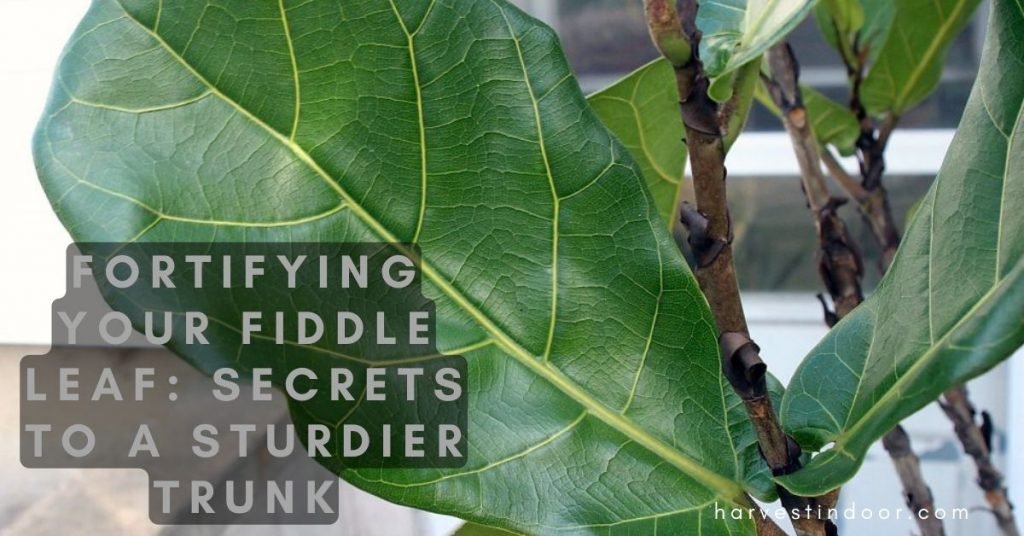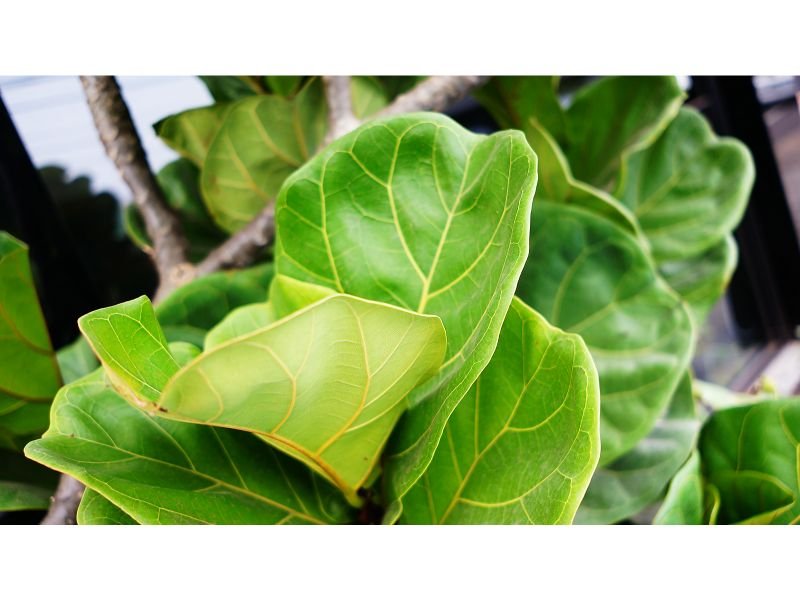Ah, the fiddle leaf fig, a majestic beauty that has taken the world of houseplants by storm. With its large, glossy leaves and elegant stature, it is no wonder why this tropical plant has become a symbol of sophistication and style in interior décor.

It graces countless living rooms, offices, and Instagram feeds, effortlessly adding a touch of greenery and elegance to any space. But let’s set aside its visual appeal for a moment and delve into one aspect that often goes unnoticed – the trunk.
Yes, my dear readers, the trunk of the fiddle leaf fig deserves our undivided attention. A strong and thick trunk not only acts as a stalwart support for this regal plant but also adds an undeniable sense of character to its overall presence.
Table of Contents
The Quest for Trunk Thickness
Now you might wonder: why all this fuss about making the fiddle leaf fig trunk thicker? Well, my friends, let me enlighten you on the matter.
Having a robust trunk is like having solid foundations for your home; it provides stability and resilience to face whatever challenges come its way. Moreover, an ample trunk is not simply an aesthetic preference; it conveys vitality and strength within your precious plant.
Picture it – a slender twig-like structure just won’t cut it in terms of visual impact or long-term durability. We need trunks that command attention, trunks that tell tales of growth and maturity.
Understanding the Fiddle Leaf Fig Trunk

The fiddle leaf fig trunk, oh how majestic it stands! Firm and sturdy, it is the backbone of this magnificent plant. Like a warrior supporting its armor, the trunk bears the weight of not only the leaves but also our admiration.
It is not just a mere stem; it is a symbol of strength and resilience. Picture this: a fiddle leaf fig with a slender, feeble trunk.
It looks like a weakling in the midst of robust plants. A thin trunk lacks presence and fails to capture attention.
On the other hand, a bulky, robust trunk exudes confidence and commands respect. It’s like having an athlete with bulging muscles versus someone with noodle-like appendages attempting to compete in a bodybuilding contest.
The Role of the Fiddle Leaf Fig Trunk
Let’s dive deeper into the essential role played by this extraordinary trunk in sustaining our beloved fiddle leaf figs. The trunk acts as both a support system and an anchor for this tropical wonder.
Standing tall and proud, it supports the heavy branches that extend outward in graceful foliage. Imagine if we were to neglect our own physical health – we would grow weak and prone to injury.
Similarly, without proper care and nourishment, our fiddle leaf fig trunks can become weak and unable to bear their own weight. A robust trunk not only ensures stability but also allows for vertical growth without fear of toppling over like an unsteady toddler taking its first steps.
Aesthetically Pleasing Powerhouses
A thicker fiddle leaf fig trunk doesn’t just serve as an indicator of health; it also adds oomph to your indoor oasis! Imagine walking into a room with lush greenery adorning every corner but being drawn to one particular plant with a thick, commanding trunk. It becomes the centerpiece, the focal point of the space.
Thicker trunks bring character and presence to your fiddle leaf fig. They emanate a sense of maturity and grandeur, elevating the overall aesthetic value of your indoor jungle. In a world filled with monotonous greenery, a robust trunk stands out like a beacon of natural beauty.
Factors Influencing Trunk Thickness

Genetics: The Untold Secret of Magnificent Trunks
When it comes to the fiddle leaf fig, there is an undeniable truth that many fail to acknowledge: genetics play a significant role in determining the thickness of its trunk. It’s like the hidden treasure chest of secrets, tucked away from the prying eyes of mere mortals.
Some fiddle leaf fig varieties are simply blessed with a genetic predisposition for robust trunks that could make even Greek gods jealous. Let’s take a moment to appreciate these exceptional varieties.
For instance, the Ficus lyrata ‘Bambino,’ with its compact size and thick trunk, stands tall as a testament to genetic marvels. Its sturdy structure exudes strength and stability, commanding respect from all who have the privilege of being in its presence.
And who can forget about the Ficus lyrata ‘Danielle,’ with its luscious leaves and trunk so girthy you can’t help but be awestruck? These natural-born beauties possess trunks that effortlessly steal everyone’s attention.
Now, before you start feeling envious of those blessed individuals who have these magnificent specimens gracing their homes, let me remind you that even if your fiddle leaf fig didn’t win the jackpot in the genetic lottery, there is still hope. With patience and dedication, you can unlock the potential within your plant and witness its trunk gradually thicken over time.
Age: The Silent Architect That Shapes Trunks
Ah, age—the silent architect that sculpts beauty at its own pace. Just like how fine wine gets better with time, fiddle leaf figs also develop thicker trunks as they mature.
It’s a mesmerizing transformation to witness as your once slender sapling grows into an impressive arboreal masterpiece. As your fiddle leaf fig ages, its growth processes naturally propel it toward a more substantial trunk.
With each passing year, the plant’s root system grows deeper and wider, establishing a strong foundation that supports its burgeoning foliage. The roots tirelessly absorb nutrients from the soil, channeling them upward to nourish every inch of the fiddle leaf fig’s being.
But let me make one thing abundantly clear: there are no shortcuts in the journey of trunk development. You can’t rush nature’s intricate dance of growth and maturity.
It takes time for your fiddle leaf fig to become a majestic specimen commanding attention and admiration from all who encounter it. So, my fellow admirers of this botanical wonder, let us embrace both genetics and age as the formidable forces that shape the destiny of our fiddle leaf figs.
Appreciate their genetic predispositions if they were fortunate enough to inherit thick-trunked lineages, but also relish in the magic of time as it molds their slender stems into majestic pillars of greenery.
Remember, nature has its own timeline—a timeline we must respect if we seek to witness the awe-inspiring transformation that comes with age and genetics intertwined harmoniously.
Nurturing Your Fiddle Leaf Fig for a Thicker Trunk
Proper Lighting: Letting the Sun Work Its Magic
Ah, sunlight! The life-giving force that has nourished our planet for billions of years.
And guess what? It can work wonders for your fiddle leaf fig too!
Providing adequate sunlight is like offering your plant a daily dose of vitamin D specifically formulated to boost trunk development. So, don’t deprive your majestic green companion of this natural delight!
Now, I know some plant enthusiasts might argue that artificial lighting can suffice. But let me tell you, there’s no substitute for the real deal.
Natural sunlight carries a spectrum of wavelengths that artificial lights simply cannot replicate. These wavelengths penetrate deep into the foliage, energizing every cell and encouraging robust growth.
So, find a sunny spot near a window or even consider moving outdoors during warmer months (just ensure it’s not too harsh). Let nature do its thing and let your fiddle leaf fig bask in the radiant glory that only genuine sunshine can provide!
Optimal Watering Practices: Hydration with Care
Watering… Ah, the ultimate balancing act of nurturing plants! When it comes to fiddle leaf figs, maintaining proper hydration levels without drowning them is an art form that requires finesse and dedication. You see, this magnificent species hailing from tropical forests enjoy moist soil but detests standing water – just like humans despise soggy socks after an unexpected rainstorm.
Here’s my controversial tip: forget about strict watering schedules! Instead, pay attention to the needs of your unique fiddle leaf fig and adapt accordingly.
Test the moisture level by gently sticking your finger an inch or two into the soil – if it feels dry at this depth (not arid Sahara desert dry), then it’s time to quench its thirst. And when you do water, be generous but not excessive, allowing the water to seep through the soil and drain freely.
Remember, moderation is key; your fiddle leaf fig doesn’t want to be treated like a desert plant, nor does it desire a constant waterlogged state. Find that sweet spot of moisture and your fiddle leaf fig will reward you with a trunk that becomes the envy of every other plant in your home.
Conclusion
Nurturing a fiddle leaf fig for a thicker trunk requires two vital components: proper lighting and optimal watering practices. Embrace the power of natural sunlight and allow it to infuse life into every fiber of your plant’s being. And when it comes to watering, ditch rigid schedules in favor of attentive observation – listening to what your fiddle leaf fig truly needs.
By implementing these techniques with care and patience, you are setting the stage for your beloved fiddle leaf fig to flourish into a majestic specimen boasting an enviable trunk that is both sturdy and visually captivating. So go forth, dear plant lover!
Unlock the potential hidden within those slender stems and witness nature’s magnificence unfold before your eyes. Your fiddle leaf fig will thank you with its ever-growing beauty – an enduring testament to the power of our nurturing hands.

Gardening is my passion and growing plants indoors has always been a stress relief for me. Grow a banana tree in my apartment once (although failed to produce bananas).






